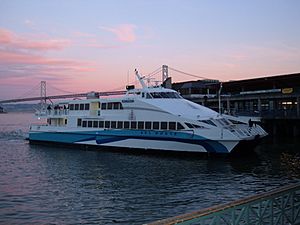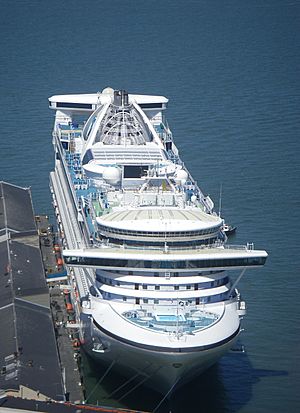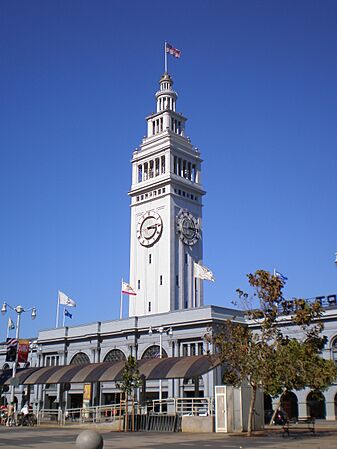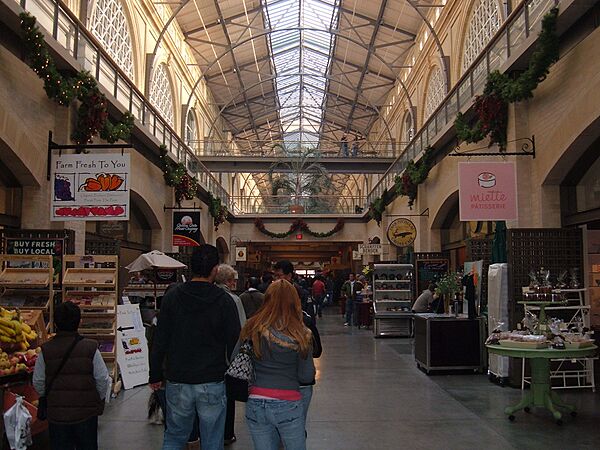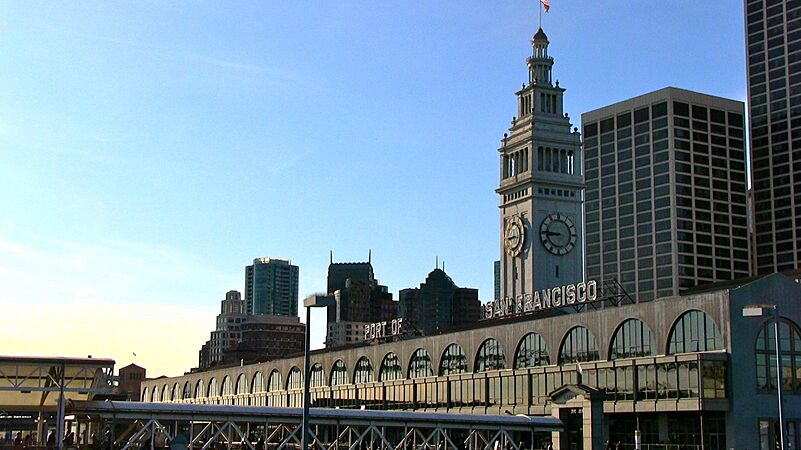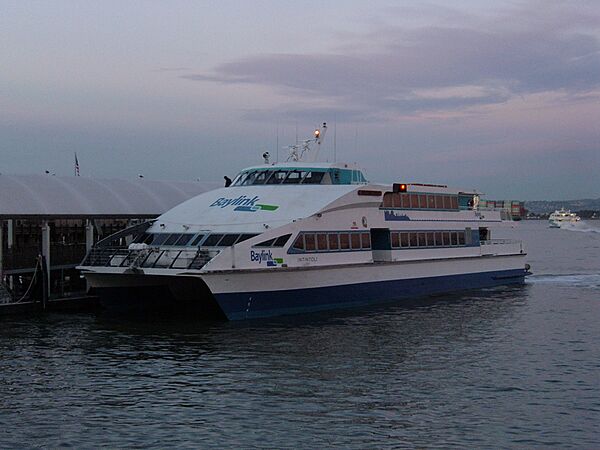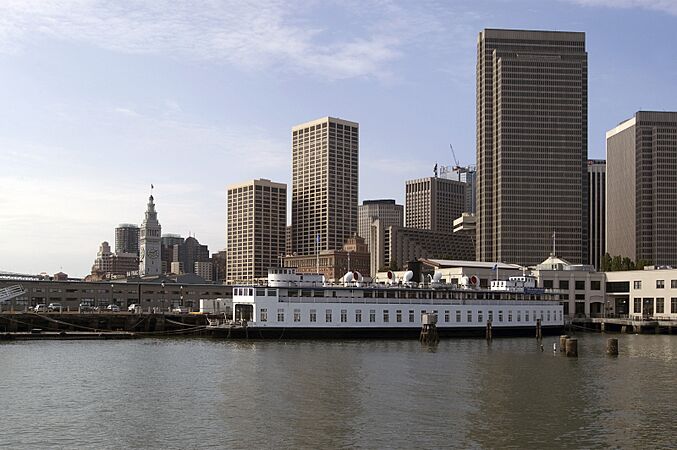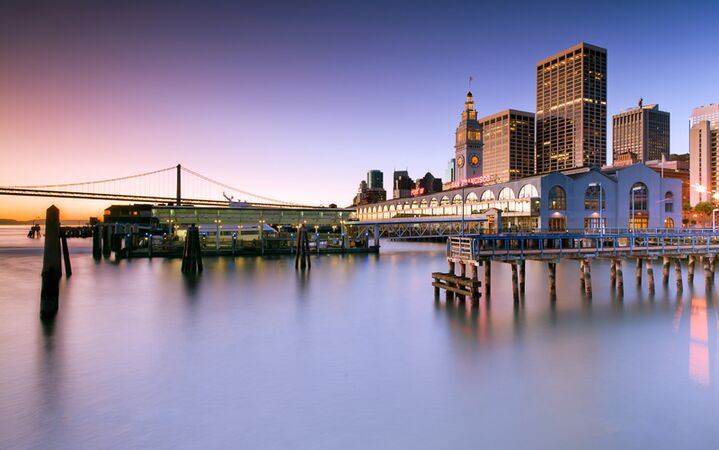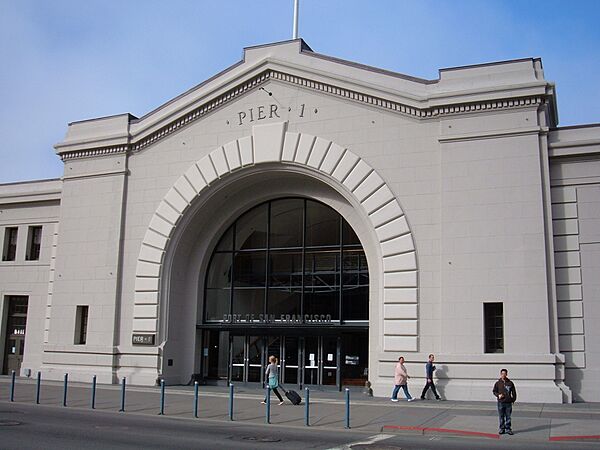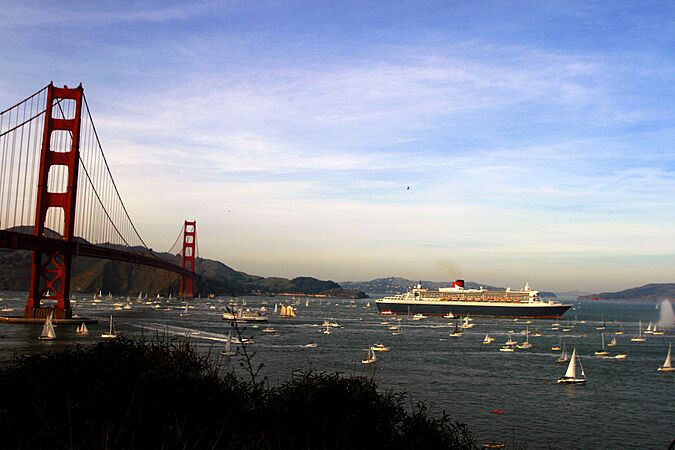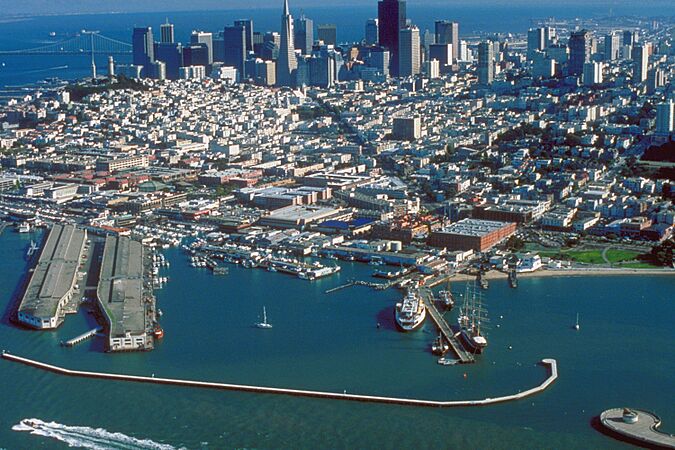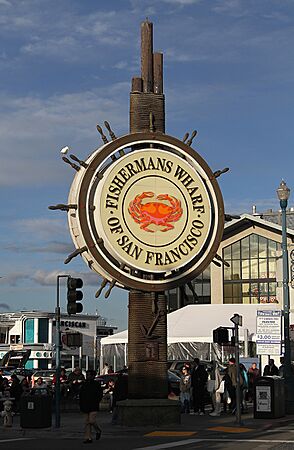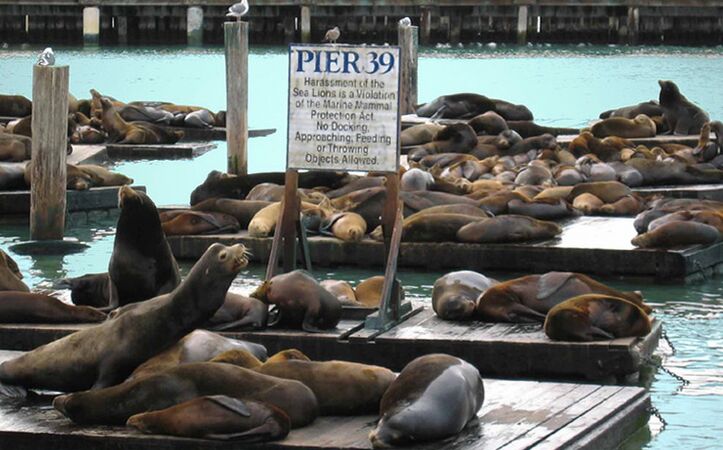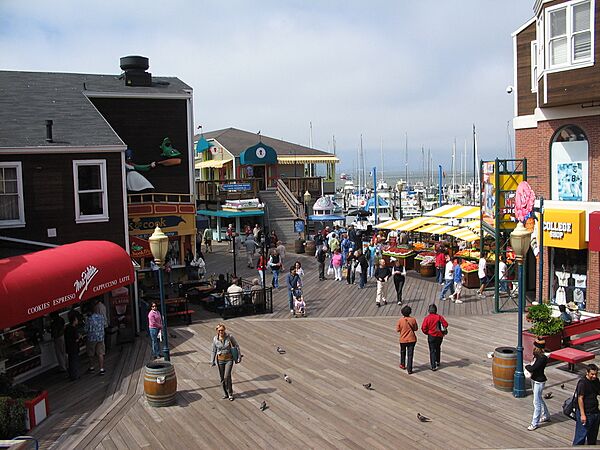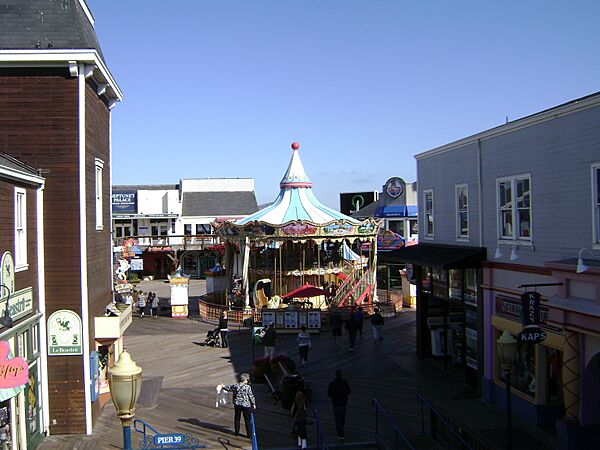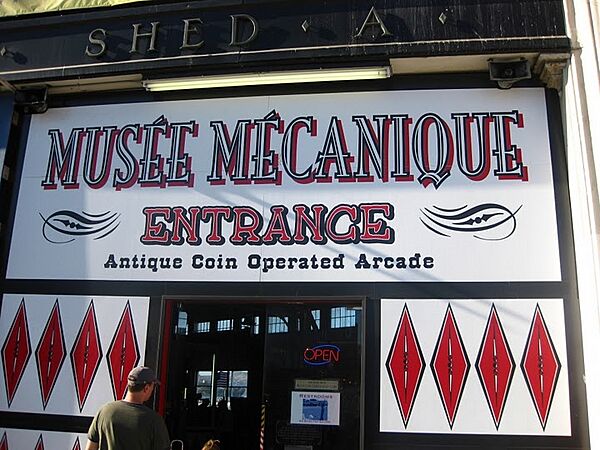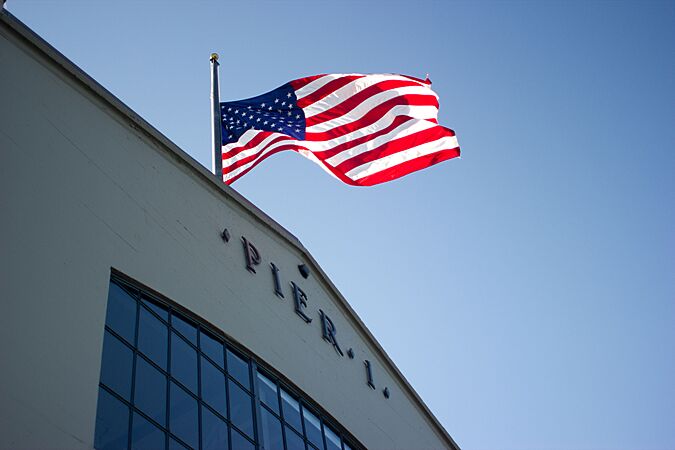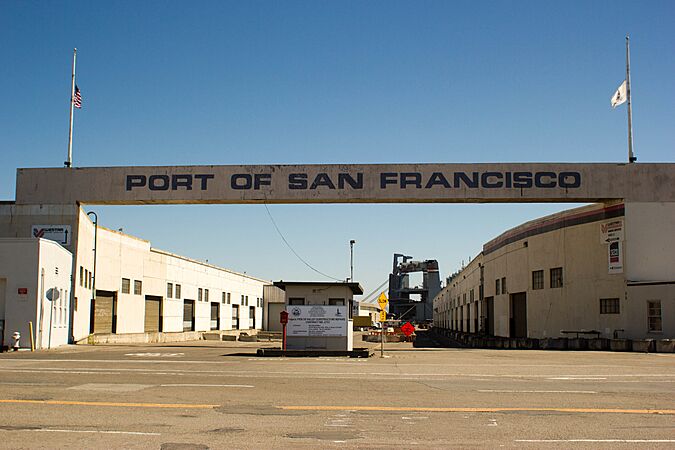Port of San Francisco facts for kids

Port Headquarters Pier 1
|
|
| Agency overview | |
|---|---|
| Formed | 1957 |
| Preceding agency |
|
| Jurisdiction | San Francisco |
| Headquarters | Pier 1 |
| Agency executives |
|
| Parent department | City and County of San Francisco |
| Website | http://www.sfport.com |
The Port of San Francisco is an organization that manages the port facilities in San Francisco, California, United States. It is run by a group of five people, chosen by the Mayor and approved by the Board of Supervisors.
The Port is in charge of a large waterfront area. This area stretches from the Golden Gate Bridge all the way around the north and east sides of San Francisco. It includes famous spots like Fisherman's Wharf and the Embarcadero. It goes south to the city line near Candlestick Point.
In 1968, the State of California gave control of the San Francisco waterfront to the City and County of San Francisco. This meant the city would now manage the port. The Port of San Francisco is known as one of the world's best natural harbors. It was once called "a port in which all the fleets of the world could find anchorage."
The Port controls nearly eight miles of waterfront land. This includes commercial buildings and piers from Hyde Street to India Basin. Some famous places managed by the Port are Fisherman's Wharf, Pier 39, the Ferry Building, and Oracle Park. In 2015, the city started a program to make the San Francisco Seawall safer from earthquakes.
Contents
A Look Back at the Port's History

The first landing spot in San Francisco was a rocky area below Telegraph Hill. This spot was later called Clarke's Point. It was a good place for ships to land.
The first port in San Francisco started in 1835. It was part of the town of Yerba Buena. Before this, the port at Monterey was the main entry point to California.
Early visitors included British and French ships. The USS St. Louis was the first American warship to fly the flag in San Francisco Bay in 1840. On July 9, 1846, the USS Portsmouth arrived. Its captain raised the American flag in the town's plaza. This plaza was later named Portsmouth Square.
In 1847, the town's name was changed from Yerba Buena to San Francisco. This was done to give the town a more recognized name.
The Gold Rush and Water Lots
When gold was found in California, San Francisco grew very fast. The city was given the right to sell "water lots." These were areas in the shallow water that could be filled in to create new land. This helped the city earn money.
Many ships were left behind in the bay during the gold rush. Some were even used as parts of the city itself. By 1851, the main wharf, Central Wharf, was very busy. Many new wharves were built. Much of early San Francisco was built on these filled-in water lots. This made the city prone to fires.
Over time, the state government took control of the waterfront. They created the Board of State Harbor Commissioners. This board managed the port separately from the city government.
Building the Seawall
In 1863, the California Board of State Harbor Commissioners was created. Their main job was to build a Seawall along the San Francisco waterfront. This project would make the waterfront straight and organized.
The Seawall was built by digging a deep trench in the mud. Huge rocks were placed in this trench to form a strong base. Concrete and masonry walls were then built on top of the rocks. The area behind the wall was filled with rock and dirt.
The building of the First transcontinental railroad in 1869 slowed down port development. But by 1871, the commissioners controlled most of the wharves. The Seawall took 50 years to finish. The last parts were completed in the China Basin.
Over the years, the commission's name changed several times. In 1957, it became the San Francisco Port Authority. Finally, in 1968, control of the port was given to the City and County of San Francisco. The new group was called the Harbor Commission of the City and County of San Francisco. It was later renamed the Port Commission of the City and County of San Francisco.
Filling the Downtown Area
To create more land, machines called "paddies" (steam shovels) dug away at the sand dunes and hills. Rock was also brought in from other places. Temporary train lines carried the dirt to fill in the muddy areas. Famous buildings like the Ferry Building were built on thousands of strong wooden poles driven deep into the ground.
The Belt Railroad
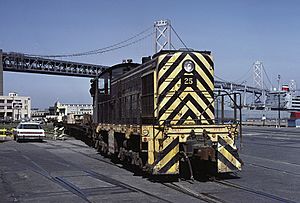
In 1890, the port commissioners started building the San Francisco Belt Railroad. This railway line was over 50 miles long. It connected every pier and warehouse to the city's industrial areas and the national railway system. This helped move goods easily.
After the 1989 Loma Prieta earthquake, much of the Belt Railroad was removed. Streetcar tracks now use some of its old path.
The Embarcadero
The Embarcadero is the eastern waterfront road of San Francisco. It was built on land created by filling in the bay. San Francisco's original shoreline was much further inland. As the city grew, the bay was filled in. A large Seawall was built, and the muddy areas behind it were filled. This created what is now San Francisco's Financial District. The Embarcadero road follows this Seawall. It was added to the National Register of Historic Places in 2002.
History of the Embarcadero Seawall
The Embarcadero Seawall was built between 1879 and 1916. It involved digging a trench, filling it with rock, and then building a wall and wharf. Over 500 acres of land were created behind the Seawall. This greatly expanded the city.
After the Seawall was built, the Port of San Francisco became very busy. In 1900, six million tons of goods passed through the Port. By 1922, with new piers, this increased to 14.5 million tons. The Ferry Building was built in 1898. It served as the main office for the Harbor Commission.
Modern Port Developments
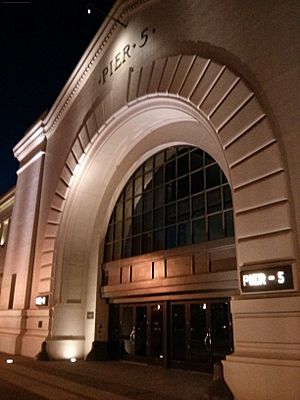
After the 1906 San Francisco earthquake, a new period of port development began. In 1909, the San Francisco Harbor Improvement Act was passed. This provided money for new projects. The Board of State Harbor Commissioners built many new piers. They paid for these projects using money earned from the busy port.
Once the modern piers were finished, the Port of San Francisco became the only port in the United States managed by a single group. By the early 1920s, the port was worth $50 million. It handled millions of dollars worth of goods each year.
In the 1920s and 1930s, many old piers were replaced with new concrete ones. The port also built the China Basin Warehouse. This building helped connect ships, trains, and trucks for moving products.
Changes in Shipping
In the 1920s, Los Angeles grew to be the largest city on the West Coast. Its ports, Los Angeles and Long Beach, became more important. San Francisco's port started to handle less cargo.
When containerization became popular in the 1960s, San Francisco's port faced challenges. It didn't have enough space to build large new container facilities. Because of this, the Port of San Francisco now focuses on special types of cargo. It also handles ship repair and ferry services.
Cargo Terminals
San Francisco's main cargo areas are at Pier 80, 92, 94, and 96.
Ship Repair
BAE Systems Ship Repair manages the ship repair facility at Pier 70. It offers full services for repairing ships.
Fisherman's Wharf
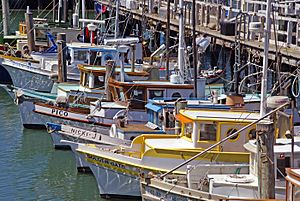
San Francisco's Fisherman's Wharf got its name from the Italian immigrant fishermen who came to the city in the 1800s. They came to take advantage of the many people arriving for the gold rush. One famous fisherman, Achille Paladini, became very rich selling seafood. He was known as the "Fish King."
Even though it's now a big tourist spot, Fisherman's Wharf is still home to many active fishermen. It's one of the busiest tourist attractions in the western United States. It's famous for Pier 39, the San Francisco Maritime National Historical Park, and many seafood restaurants. People especially love the Dungeness crab and clam chowder served in a sourdough bread bowl.
Pier 39
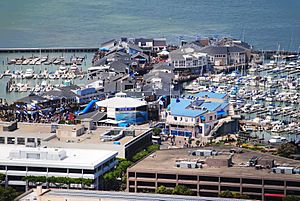
Pier 39 was created by Warren Simmons and opened in 1978. It is a shopping center and a very popular place for tourists. It has shops, restaurants, games, and street performers. You can also see California sea lions resting on the docks. The Aquarium of the Bay is also located here. A two-story carousel is a fun feature at the pier.
Ferry Building

The San Francisco Ferry Building was built by the Harbor Commission. It was a very good investment for the state. It survived the 1906 earthquake with little damage. In the 1920s, 50 million passengers used the ferries each year. Ships also arrived with goods from the Sacramento and San Joaquin Valleys.
In 2003, the building was renovated. It now has a modern ferry terminal and a gourmet marketplace. The upper floors are used for offices. San Francisco Bay Ferry and Golden Gate Ferry operate from here. They take passengers to different places around the San Francisco Bay.
Central Embarcadero Piers Historic District
This area is a Registered Historic District. It includes Piers 1, 1 1/2, 3, and 5. It is one of the largest groups of old piers still standing along San Francisco's Embarcadero. It was added to the National Register of Historic Places in 2002.
Historic Streetcars
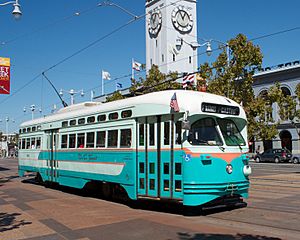
The F Market & Wharves line uses old streetcars from San Francisco and other cities. It's a fun way to see the waterfront. In March 2000, the F line started going all the way to Fisherman's Wharf.
The E Embarcadero became San Francisco's second historic streetcar line in 2016. It runs along the entire Embarcadero.
Exploratorium
The Exploratorium is a science museum in San Francisco. It has created over 1,000 hands-on exhibits that mix science and art. Many people see it as a model for other interactive museums around the world. In 2013, the Exploratorium moved to its new home on Piers 15 and 17 along The Embarcadero.
Cruise Terminal
The new James R. Herman Cruise Terminal at Pier 27 opened in 2014. It replaced the older Pier 35. This modern terminal has better power for ships and more space for passengers.
The port handles many cruise ship visits each year. It expects even more in the future. Cruises from San Francisco go to places like Alaska and Hawaii. The Queen Mary 2 is the largest cruise ship to have docked in San Francisco.
Oracle Park
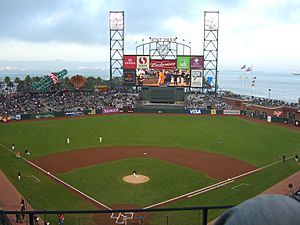
Oracle Park is a baseball stadium in San Francisco. It is the home of the San Francisco Giants baseball team. The Giants rent the land for the park from the Port of San Francisco.
Embarcadero Seawall Program
The city, through the Port of San Francisco, started the Embarcadero Seawall Program. This program aims to make the Seawall safer from earthquakes. It also plans for better flood protection and how to deal with rising sea levels.
Rebuilding the Embarcadero Seawall is a huge project. It is expected to cost up to $5 billion and take many decades. The first part of the project will focus on the most important safety improvements. This first part will cost $500 million. Voters approved $425 million for this project in November 2018.
Future Plans
Pier 70
The Port of San Francisco owns a large area at Pier 70, San Francisco, California. This area has many old industrial buildings from the 1800s. It was once a major center for iron and steel mills and shipbuilding. Today, BAE Systems Ship Repair operates there.
Past Plans That Were Canceled
Warriors Arena
In 2012, the Golden State Warriors basketball team planned to build a new arena on Piers 30–32. This arena would have held 19,000 people. However, in 2014, the Warriors changed their plans. They decided to build their new arena in the Mission Bay neighborhood instead.
USS Iowa
In 2006, the US Navy wanted to dock the retired USS Iowa battleship in Fisherman's Wharf. The idea was to turn it into a floating museum. However, the city's leaders voted against it. In 2012, the battleship opened as a museum at the Port of Los Angeles.
Images for kids
See also
 In Spanish: Puerto de San Francisco para niños
In Spanish: Puerto de San Francisco para niños



